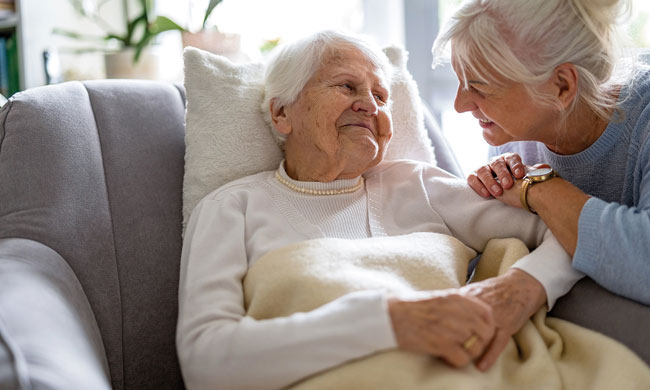HEALTHY LIVING
Make sense of your travel preferences


(Family Features) Seasoned travelers know that no two trips are exactly the same, even when revisiting the same location. The weather changes, your personal life and perspective evolve and any combination of factors makes each experience unique. However, if you’re like most travelers, your preferences guide your journeys no matter how far you venture from home.
According to a survey of American travelers from vacation rental app and website Vrbo, people are united by a common desire to travel with friends and family. In fact, 52% of respondents said a family vacation is their reason for travel in 2019, and more people said they will travel with a group of four or more this year than last year. That’s where the generational similarities end, however.
Determining where to go and what you’ll do depends quite a bit on your age. Your stage of life significantly impacts the places you dream about visiting, the reasons you travel and what you look for when you get there, according to the survey.
What to look for in a destination
Your definition of a dream vacation is likely to shift along with variables like your life stage, income and available free time. Limitations in any of those areas may make a certain destination a far-off dream during one stage of life but an attainable retreat during another.
The disparity between dream and reality signals that barriers of time and money are the deciding factors for whether Americans will take that dream vacation. This holds true for every age group, although millennials (37%) are more likely to go into debt for travel than Generation Xers (27%) and baby boomers (15%).
Reasons for traveling
Relaxation is a primary reason for traveling, which can help you disconnect from the stress of daily life and reconnect with family and friends. Whether it’s curiosity or a much-anticipated trip to celebrate a special occasion with a family member, many trips have a specific purpose. Understanding why you want to travel can make it much easier to plan.
Although younger travelers are most likely to make exploration a priority on their journeys, the Vrbo survey revealed that travel isn’t always about adventure, as 20% of travelers ages 35-54 are likely to travel for a special occasion like a birthday or anniversary. In addition, only 6% of baby boomers said they would travel for a hobby or activity like skiing, surfing or hiking, compared with 23% of millennial respondents.
Amenities that matter
The amenities you can access during your getaway may vary greatly depending on where you go and the type of trip you plan. From electronics and fully stocked kitchens to swimming pools and pet-friendly features, plenty of options are available to help ensure your perfect vacation lodging includes all the amenities you require.
If you’re like most travelers, keeping connected is a major requirement. In fact, 75% of respondents listed access to the internet via WiFi as an important amenity when traveling, outranking traditional must-haves like TV and air-conditioning, according to the survey.
Amenities like WiFi aside, accommodation preferences reflect the starkest generational differences among American travelers. Millennials (71%) are most likely to consider unique lodging options such as boats or treehouses. They also represent the age group most likely to take into account design and architecture when choosing a place to stay. Generation Xers voiced the strongest preference for having ample space for everyone in the party. For baby boomers, more than other age groups, noise level is important when selecting lodging.
Find getaway accommodations perfect for every stage of life at vrbo.com.
Photo courtesy of Getty Images
SOURCE:
Vrbo
HEALTHY LIVING
3 essential steps to love your heart

(Family Features) Taking steps to improve your overall health can help you live a longer, healthier life. One key component of overall well-being – heart health – is especially critical as heart disease has been the leading cause of death among Americans since 1950, according to the Centers for Disease Control and Prevention.
Adopting habits like exercising regularly, eating a heart-healthy diet with lots of vegetables and fruits like grapes and getting the proper amount of sleep can set you on the right path.
Eat a Heart-Healthy Diet
A diet rich in fruits, vegetables, whole grains, lean proteins and healthy fats can have a positive impact on heart health and may lower your risk for heart disease. For example, grapes are easy to keep on hand as a heart-healthy snack. They have no saturated fat or cholesterol and are low in sodium; contain 7% of the daily recommended intake of potassium; and are a good source of vitamin K. Grapes are also a natural source of beneficial antioxidants and other polyphenols and help maintain healthy circulation by promoting the relaxation of blood vessels.
Whether enjoying them by the handful on their own or as part of recipes like these Baked Grape Falafel Bites, where Grapes from California add juicy goodness to a classic chickpea fritter, grapes are a perfect ingredient for heart-friendly eating plans. Research suggests eating grapes daily helps support heart health. In one study, for example, women who consumed 1 1/4 cups of grapes every day benefited from reduced blood triglyceride levels, LDL cholesterol levels, inflammatory proteins and other markers of heart disease.
Exercise Regularly
Getting at least 150 minutes per week of moderate-intensity aerobic activity or 75 minutes of vigorous aerobic activity, as recommended by the American Heart Association, can have a positive impact on heart health by lowering blood pressure, reducing inflammation and aiding in maintaining a healthy weight.
Get the Proper Amount of Sleep
A crucial component of heart health, experts recommend adults get 7-9 hours of sleep each night. Creating a cozy sleep space by turning off electronics and setting the thermostat to a comfortable temperature is the first step toward a restful night’s sleep. Also aim for consistency with your bedtime routine, including going to sleep and waking at the same times each day (including weekends), for best results.
Learn more about the heart-health benefits of grapes, and find additional heart-friendly recipes, at GrapesFromCalifornia.com.

Baked Grape Falafel Bites
- 1 cup dried chickpeas, rinsed
- cold water, for soaking
- 1 cup loosely packed fresh parsley leaves
- 1/2 cup loosely packed fresh cilantro leaves
- 4 garlic cloves, peeled
- 1 medium onion, peeled and cut in wedges
- 1 teaspoon ground cumin
- 1 teaspoon salt
- 1 teaspoon baking powder
- 1/3 cup all-purpose flour
- 18 red Grapes from California
- vegetable oil cooking spray
- tahini sauce or baba ghanoush, for dipping
- In medium bowl, cover chickpeas with at least 2 inches cold water. Let soak at least 12 hours, or overnight, at room temperature.
- To make falafel bites: Drain soaked chickpeas, rinse well in colander and let stand.
- In bowl of food processor, process parsley and cilantro until chopped herbs stick to sides of bowl. Do not scrape down. With motor still running, drop garlic through feed tube; it will also stick to sides of bowl. Remove lid, add onion and pulse to chop well. Add chickpeas, cumin, salt and baking powder. Scrape everything off sides of bowl and process until mixture is well chopped and looks mealy. Add flour and pulse to blend. Cover mixture and chill at least 1 hour.
- Using 1-ounce scoop or tablespoon, drop 2-tablespoon mounds of chickpea mixture onto plate. Shape into balls, stuffing one grape inside each.
- Heat oven to 350 F. Line baking sheet with foil then parchment paper.
- Place falafel balls on sheet and spray with vegetable oil cooking spray. Bake 20 minutes, turning 1-2 times with tongs, until golden brown.
Nutritional information per serving: 240 calories; 8 g protein; 30 g carbohydrates; 11 g fat (41% calories from fat); 1 g saturated fat (4% calories from saturated fat); 0 mg cholesterol; 480 mg sodium; 6 g fiber.
HEALTHY LIVING
Fight back against free Rrdicals: Expert advice to prevent skin damage

(Family Features) In a healthy person, the body is like a well-oiled machine. However, sometimes things go wrong, and when that happens, finding the source of damage, illness or disease often requires a deeper look. In many cases, the culprit is free radicals.
The experts at Heliocare, makers of daily dietary supplements with powerful formulas that have antioxidant effects, explain how to help neutralize the effects of free radicals and reduce their impact.
What are free radicals anyway?
One would probably need some knowledge of chemistry to fully understand free radicals, but simply put, the natural process of the body’s cell metabolism can create unstable molecules, i.e., free radicals. There are also numerous sources of environmental free radicals, including air pollution, radiation, medications and pesticides, as well as certain foods, alcohol and even exercise.
The body naturally produces antioxidants to keep free radicals in check, but if too many of them accumulate, they can create oxidative stress.
What kinds of damage can free radicals cause?
Excess free radicals, and in turn oxidative stress, can impact how the body ages and produce visible evidence such as wrinkles and sunspots. There is evidence that free radicals may also contribute to the formation of some diseases and conditions, including accelerated signs of aging.
How can you reduce their impact?
It’s impossible to eliminate free radicals completely. However, you can take steps to protect your body, and especially your skin, from their harmful impacts with a few simple everyday actions.
- Reduce exposure: Avoid spending excess time in the sun and always use sunscreen. Limit your alcohol consumption and avoid smoking (including secondhand smoke). Be conscious of air pollution and use air purifiers.
- Increase antioxidants: Elevating the amount of antioxidants in your body is another way you can offset free radicals. Many dermatologists recommend dietary supplements like Heliocare Daily Use Antioxidant Formula, a clinically proven supplement with antioxidant properties due to proprietary Fernblock PLE Technology that harnesses the power of the unique polypodium leucotomos fern. The antioxidant properties in this oral supplement aids in eliminating free radicals, helping to protect your skin from their effects that can cause wrinkles, discoloration and other signs of environmental aging.
- Manage your stress levels: High levels of stress, both physical and emotional, can lead to stress hormones generating free radicals. Practice mindfulness, do things you enjoy and consider habits like meditation or yoga to keep stress levels in check.
- Fight with your diet: Eating plenty of antioxidant-rich foods can also reduce your risk of free radical damage. Examples include produce rich in vitamin C, like broccoli, cauliflower, leafy greens, strawberries and grapefruit.
Learn more about protecting your body and skin from free radicals at heliocare.com.
Photo courtesy of Shutterstock
SOURCE:
Heliocare
HEALTHY LIVING
Have a heart for caregivers: 8 expert tips for volunteers to care for themselves, too

(Family Features) Survivors of heart attacks or strokes may have additional health and personal care needs, often relying on a family member or close friend to help. While caregivers take on a valuable role, they also pay unique physical and emotional tolls.
In fact, a growing body of scientific research shows people who serve as unpaid caregivers may not get the care they need to live longer, healthier lives, according to the American Heart Association, which is celebrating 100 years of lifesaving service.
Caregiving typically involves a range of duties from providing health care services, such as changing bandages and giving medications, to helping with personal needs like bathing, dressing and meal preparation. Administrative tasks like scheduling medical appointments, filing insurance claims and paying household bills may also be necessary.
The Centers for Disease Control and Prevention reported 1 in 5 U.S. adults provides some form of regular care or assistance to a family member or friend with a health problem or disability; 58% are women and nearly one-third provide care for at least 20 hours per week.
“The typical caregiver likely has an ever-growing and changing to-do list and most of them probably do not add ‘take care of myself’ to that list,” said American Heart Association volunteer Lisa Kitko, Ph.D., R.N., FAHA, dean of the University of Rochester School of Nursing and vice president of the University of Rochester Medical Center. “While caregiving can be a very rewarding experience, it can also take a huge physical and mental toll on even the strongest person.”
Prioritizing your own physical, mental and emotional health allows you to better help your loved one, Kitko said. Consider her tips for caregivers to care for themselves:
- Knowledge is power. Learn everything you can about your loved one’s condition.
- Set boundaries. Say “no” when it’s appropriate, don’t dwell on what you can’t change and recognize you’re trying your best.
- Maintain a healthy diet, limit caffeine and get adequate rest.
- Stay current with your own medical and dental appointments. Inform your health care provider if you’re experiencing any signs of depression.
- Find a support system. Share your feelings with someone who wants to listen or understands what you’re feeling, like the American Heart Association’s online Support Network, which includes a section just for caregivers.
- Nurture your spiritual life and focus on things you’re grateful for each day.
- Make time for yourself and friends. Participate in activities you enjoy, including regular physical activity.
- Be prepared for possible medical emergencies. If you’re caring for someone at risk for heart attack or stroke, recognize the warning signs and call 9-1-1 if he or she experience any. Learn Hands-Only CPR; research shows most out-of-hospital cardiac arrests happen in the home. Be ready to save a life by calling 9-1-1 and pushing hard and fast in the center of the chest.
“‘Take care of yourself so you can take care of others,’ are definitely words to live by for caregivers – everyone tells you that and it certainly makes sense, but it’s hard,” Kitko said. “There is a lot of stress associated with knowing someone is depending on you … That is why taking care of yourself really should be the first item on your caregiver checklist.”
Learn more about caregiving and cardiovascular disease at heart.org.
Photo courtesy of Shutterstock
SOURCE:
American Heart Association
-

 NEWS2 years ago
NEWS2 years ago2 hurt, 1 jailed after shooting incident north of Nocona
-

 NEWS10 months ago
NEWS10 months agoSuspect indicted, jailed in Tia Hutson murder
-

 NEWS1 year ago
NEWS1 year agoSO investigating possible murder/suicide
-

 NEWS2 years ago
NEWS2 years agoWreck takes the life of BHS teen, 16
-

 NEWS1 year ago
NEWS1 year agoMurder unsolved – 1 year later Tia Hutson’s family angry, frustrated with no arrest
-

 NEWS1 year ago
NEWS1 year agoSheriff’s office called out to infant’s death
-

 NEWS2 years ago
NEWS2 years agoBowie Police face three-hour standoff after possible domestic fight
-

 NEWS2 years ago
NEWS2 years agoDriver stopped by a man running into the street, robbed at knifepoint





